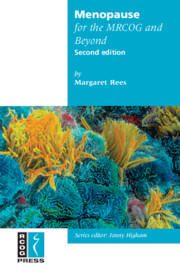Book contents
- Frontmatter
- Contents
- Preface
- Abbreviations
- 1 Definitions and controversies
- 2 Explaining risk
- 3 Systemic hormone replacement therapy
- 4 Non-HRT options for osteoporosis
- 5 Diet and lifestyle
- 6 Alternative and complementary therapies
- 7 Vasomotor symptoms, urogenital and sexual problems
- 8 Osteoporosis and autoimmune arthritis
- 9 Breast disease
- 10 Benign and malignant gynaecological disease
- 11 Premature menopause
- 12 Women with concomitant medical conditions
- Index
5 - Diet and lifestyle
Published online by Cambridge University Press: 05 July 2014
- Frontmatter
- Contents
- Preface
- Abbreviations
- 1 Definitions and controversies
- 2 Explaining risk
- 3 Systemic hormone replacement therapy
- 4 Non-HRT options for osteoporosis
- 5 Diet and lifestyle
- 6 Alternative and complementary therapies
- 7 Vasomotor symptoms, urogenital and sexual problems
- 8 Osteoporosis and autoimmune arthritis
- 9 Breast disease
- 10 Benign and malignant gynaecological disease
- 11 Premature menopause
- 12 Women with concomitant medical conditions
- Index
Summary
This chapter examines diet, exercise, smoking cessation and weight loss. Notwithstanding the obesity epidemic, undernutrition in the elderly is a significant medical problem. It leads to the ‘anorexia of ageing’ and is associated with increased morbidity and mortality. The nutritional requirements of older women are of increasing interest as more are living into their 80s and beyond. Exercise needs to be promoted and continued, as it maintains muscle and bone mass and thus prevents falls and osteoporotic fractures.
Diet
Dietary components can be classified into macronutrients, micronutrients and functional foods.
MACRONUTRIENTS
Macronutrients encompass carbohydrate, protein and fat.
Carbohydrate
The World Health Organization has recommended that 55—75% of energy input should come from carbohydrate, with less than 10% from free sugars. The proportion coming from non-milk extrinsic sugars, from foods such as sugar and preserves, is important. Diets high in non-milk extrinsic sugars may reduce intake of foods that are more nutrient dense. More emphasis is needed on other carbohydrate-rich foods (such as wholegrain breakfast cereals, grains and breads), which also provide fibre and some B vitamins.
Protein
Current recommendations are 10—15% of total energy intake. As lean body mass decreases with age, protein requirements increase to maintain nitrogen equilibrium. Demand further increases in wound healing (including fractures), infection and restoring muscle mass lost from immobility.
Fat
The World Health Organization has recommended that total fat intake should account for 15—30% of total energy intake, with saturated fats accounting for less than 10% and polyunsaturated fats for 6—10%.
- Type
- Chapter
- Information
- Menopause for the MRCOG and Beyond , pp. 33 - 42Publisher: Cambridge University PressPrint publication year: 2008

